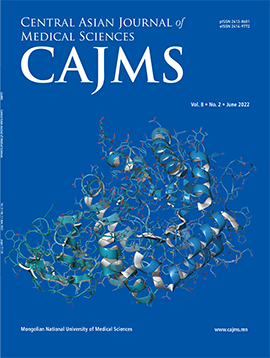Some Diagnostic Aspects of Dermatophytes in Mongolia
DOI:
https://doi.org/10.24079/cajms.2021.06.012Keywords:
Mongolia, Dermatophytes, Trichophyton, Microsporum, EpidermophytonAbstract
Objectives: We sought to determine the distribution of the different dermatophyte species diagnosed in Ulaanbaatar, Mongolia. Methods: A total of 281 participants were suspected of having dermatomycotic lesions. Material collected from skin, hair, and nails were submitted to direct microscopy examination using KOH, cultured in Sabouraud dextrose agar, to identify the 131 dermatophytes isolated. Results: 142 (50.5%) of 281 participants were males and 139 (49.5%) were females. The mean (±SD) age of the patients was 29.92 ± 21.73 years. Among the 281 mycological suspects cases, 131 patients had dermatophyte infections based on culture. Tissues with positive cultures were the skin (41%, 73), nails (20.7%, 37), and hair (11.8%, 21). The fungal infection locations were the nails (20.79%, 37), followed by the face (11.24%, 20), soles in the feet (11.24%, 20), and body (7.87%, 14). Onychomycosis (13.1%, 37) was the common clinical form of dermatomycosis, followed by tinea corporis (18.8%, 53), tinea capitis (7.5%, 21), and tinea pedis (7.1%, 20). The most common fungal infection was onychomycosis caused by the anthropophilic species Trichophyton Rubrum. The most isolated dermatophyte was Trichophyton Rubrum (26.7%, 35), followed by Microsporum Canis (19.8%, 26) and Trichophyton Tonsurans (13.7%, 18). Conclusion: Our data provide a valuable baseline on which to assess future efforts directed toward preventing dermatophytosis infections in our epidemiological setting.
Downloads
236
Downloads
Published
How to Cite
Issue
Section
License
Copyright (c) 2021 Mongolian National University of Medical Sciences

This work is licensed under a Creative Commons Attribution-NonCommercial 4.0 International License.




